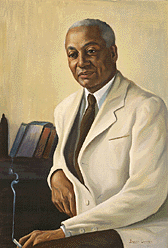
Alain Locke on Identity and Human Rights
Of Alain Locke, Martin Luther King Jr. said:
“We’re going to let our children know that the only philosophers that lived were not Plato and Aristotle, but W. E. B. Du Bois and Alain Locke came through the universe.”

In this article we explore an idea in the work of Alain Locke – the idea that identity and oppression are related to each other. That the pathway to emancipation is through re-imagining our identity. Early on he explored these themes in the introduction he wrote to his 1925 anthology titled “The New Negro“.
The tribute above, particularly from Martin Luther King, calls for greater attention to Alain Locke’s philosophy and contribution. Alain Locke is well known to a body of scholars. Just recently, on 13 September 2014, an interment ceremony was held for his ashes at the U.S. Congressional Cemetery. His ashes had been kept in a university drawer for 60 years.[1][2] The ceremony is a hopeful sign that the world is beginning to pay renewed attention to Alain Locke’s thought.
At lot more could be said about Alain Locke’s life and career as a writer, philosopher, and race equality advocate. We’ll explore his life further in future articles. At this point it is useful to know that he was a professor of philosophy at Howard University, and he that he was an advocate of racial equality from early in his life. Indeed, he was among the first to challenge the notion that ‘race’ was a fixed biological reality. Correctly seeing ‘race’ as a socially constructed and fluid artefact, at a time when most of society, including its leading thinkers, were subscribing to theories of scientific racism. His experience of oppression as an African American pursuing a life as a scholar was a major influence in his life. Another important influence on his thought was the Baha’i Faith, of which he was a member, and from which he drew an increasingly universalist philosophy as he explored his work.
Here we will focus on his insights about identity. Essentially, the point that Alain Locke makes in the introduction to The New Negro, is that how we and others see ourselves is central to our emancipation. It was an insight born in the experience of racial discrimination and segregation.
It is possible that the women’s movement influenced Alain Locke’s thoughts on this point, as there is a similar thread in first wave and later feminism. It may be however that the parallel is simply a shared insight arising from the experience of oppression.
Alain Locke and The New Negro
The New Negro explores identity by anticipating, proclaiming and furthering an intellectual and cultural flowering among African Americans known as the “Harlem Renaissance”. The Renaissance was an artistic and cultural movement that flourished in Harlem in the pre-war years until the Great Depression and other factors brought the movement to an end.
Locke expressed his concept as follows:
… the Old Negro had long become more of a myth than a man. The Old Negro, we must remember, was a creature of moral debate and historical controversy. His has been a stock figure perpetuated as an historical fiction partly in innocent sentimentalism, partly in deliberate reactionism. … So for generations in the mind of America, the Negro has been more of a formula than a human being ⎯ a something to be argued about, condemned or defended, to be “kept down,” or “in his place,” or “helped up,” to be worried with or worried over, harassed or patronized, a social bogey or a social burden. The thinking Negro even has been induced to share this same general attitude, to focus his attention on controversial issues, to see himself in the distorted perspective of a social problem. His shadow, so to speak, has been more real to him than his personality. … Little true social or self-understanding has or could come from such a situation. …
Although exploring its dimensions, Locke doesn’t try to create or impose a rigid definition of what the ‘New Negro’ should be. As he says, he leaves this task to the rising generation.

The New Negro primarily showcases a diversity of African-American art, culture and literature, from traditional negro spirituals and their influence on American music, to the philosophy of W.E.B. Du Bois. Through art and culture The New Negro manifests a new identity that demolishes racist myths and limiting self-conceptions that served to keep African Americans in subjugation.
The New Negro was a powerful intellectual and cultural response to the Jim Crow era, with its lynchings, its scientific racism, its “race hygiene”, its social Darwinism, its criminalization of “race mixing” and its entrenchment of legal segregation.
Locke contributed in other ways on the question of identity. As suggested above, he was a trenchant critic of scientific racism, using reason and philosophy to attack claims around race and culture that lacked scientific validity. (Harris, p 164 and following)
In Locke’s 1950 retrospective on the New Negro and its associated movement, he reflects both on what he meant, and where he thought identity might trend. He does so however in a context in which he draws his readers attention to the difficulty of defining “Negro art”, based on a constructed racial category that ultimately must remain contingent and shifting. He states of the movement that:
From the beginning racial chauvinism was supposed to be ruled out; five of the collaborators of The New Negro were whites whose readily accepted passport was competent understanding of the cultural objectives of the movement and creative participation in them. The substance of Negro life was emphasized, not its complexion. …
So far as the emancipation of the public mind from prejudice and group stereotypes, this may be properly regarded as … a new Negro contribution to the broadening of the nation’s culture. But for us as Negroes, it is even more important to realize how necessary it is to share understandingly and participate creatively in these promising enlargements of the common mind and spirit. To be democratic is as important is it is to be treated democratically; democracy is a two-way process and accomplishment. (Harris, pp 230 and following)
Alain Locke: Stretching the Social Mind
We see more of Locke’s thought, in the 1944 commencement address titled “Stretching our Social Mind” which Alain Locke gave to the Hampton Institute (now Hampton University), Virginia. He returns to the issues of identity at a group level.
Part of the lot of any oppressed or persecuted minority is an acute and sometimes morbid social consciousness. To this the Negro is no exception. One of the most important issues before us as a racial group today is to broaden our deep but often too narrow group consciousness and channel it toward the progressive goals and movements of these modern times. Neither reactionary, subservient inter-racialism of the traditional sort nor narrow chauvinistic racialism are a proper and adequate base for our present-day thinking or our present-day group planning and action. It is high time, therefore, to stretch our social minds and achieve thereby a new dynamic as well as new alliances in the common fight for human justice and freedom of which our minority cause is a vital but nonetheless only a fractional part.
… just as world-mindedness must dominate and remould nation-mindedness, so we must transform eventually race-mindedness into human-mindedness. Today it is possible and necessary for Negroes to conceive their special disabilities as flaws in the general democratic structure. The intelligent and effective righting of our racial wrongs and handicaps involves pleading and righting the cause of any and all oppressed minorities. In making common cause with all such broader issues, we shall find that we strengthen, both morally and practically, our own.
As Locke pointed to a reshaping of African American identity to seize the ‘high ground’ of arts and culture in the 1920’s as a response to oppressive stereotypes, in the 1940s, he again suggests a re-framing – the conscious creation of a social identity concerned with collective human emancipation.
In this journey, Locke takes African American identity from that of victims of racial oppression to leaders in human emancipation.
Alain Locke’s Influence
That Locke’s thoughts and teaching had real world impact, we need merely look at Martin Luther King Jr., who in his work, did exactly what Alain Locke advocated. When in 1965 President Johnson used the words “We shall overcome“, borrowed from civil rights leaders, in introducing the Voting Rights Act and presented the pen used to sign the Voting Rights Act into law, to Martin Luther King, it was a tribute to the contribution that African Americans had made to the life of America. It was an actualization of Locke’s vision. As President Johnson said:
The real hero of this struggle is the American Negro. His actions and protests, his courage to risk safety, and even to risk his life, have awakened the conscience of this nation. His demonstrations have been designed to call attention to injustice, designed to provoke change; designed to stir reform. He has been called upon to make good the promise of America. And who among us can say that we would have made the same progress were it not for his persistent bravery and his faith in American democracy?
It is notable that such creative use of identity to advance human rights has been largely muted in today’s human rights discourse. The question of identity and the contribution it might make in the context of human rights in the 21st century is deserving of renewed thought and attention.
Epilogue: The Message of the Harlem Renaissance
Linked here is a silent movie illustrative of the Harlem Renaissance. Alain Locke seems to me to have been overly self-critical in his retrospective on it. The movie is worth viewing as its portrayal of African American artists is striking even today. We rarely see such images in mass media. It is a reminder that the negative and stereotyped portrayal of race which Locke critiques and fought to eliminate are yet to be fully confined to the past. A virtual tour of the art of African American artists can be taken through the National Gallery of Art U.S.A.
Acknowledgements
I would like to acknowledge the kind and helpful comments of Christopher Buck PhD., on an earlier version of this article.
Bibliography
Alain Locke (ed), The New Negro: Voices of the Harlem Renaissance,
Touchstone, 1925
Leonard Harris (ed), The Philosophy of Alain Locke – Harlem Renaissance and Beyond Temple University Press Philadelphia, 1989
Christopher Buck, Alain Locke – Faith and Philosophy, Kalimat Press, Los Angeles, 2005
Christopher Buck and Betty Fisher, Four Talks Redefining Democracy, Education and World Citizenship, World Order, Vol 38, No 3
Related articles





